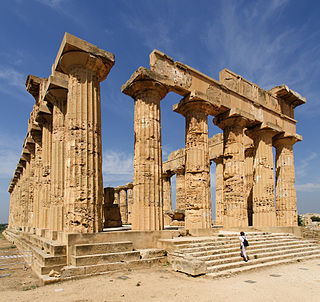
Selinunte was a rich and extensive ancient Greek city of Magna Graecia on the south-western coast of Sicily in Italy. It was situated between the valleys of the Cottone and Modione rivers. It now lies in the comune of Castelvetrano, between the frazioni of Triscina di Selinunte in the west and Marinella di Selinunte in the east.

Ancient Roman architecture adopted the external language of classical ancient Greek architecture for the purposes of the ancient Romans, but was different from Greek buildings, becoming a new architectural style. The two styles are often considered one body of classical architecture. Roman architecture flourished in the Roman Republic and to an even greater extent under the Empire, when the great majority of surviving buildings were constructed. It used new materials, particularly Roman concrete, and newer technologies such as the arch and the dome to make buildings that were typically strong and well engineered. Large numbers remain in some form across the former empire, sometimes complete and still in use today.

Asclepius is a hero and god of medicine in ancient Greek religion and mythology. He is the son of Apollo and Coronis, or Arsinoe, or of Apollo alone. Asclepius represents the healing aspect of the medical arts; his daughters, the "Asclepiades", are: Hygieia, Iaso, Aceso, Aegle and Panacea. He has several sons as well. He was associated with the Roman/Etruscan god Vediovis and the Egyptian Imhotep. He shared with Apollo the epithet Paean. The rod of Asclepius, a snake-entwined staff, remains a symbol of medicine today. Those physicians and attendants who served this god were known as the Therapeutae of Asclepius.
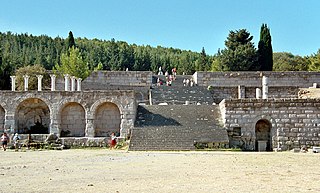
Asclepieia were healing temples in ancient Greece, dedicated to Asclepius, the first doctor-demigod in Greek mythology. Asclepius was said to have been such a skilled doctor that he could even raise people from the dead. So stemming from the myth of his great healing powers, pilgrims would flock to temples built in his honor in order to seek spiritual and physical healing.
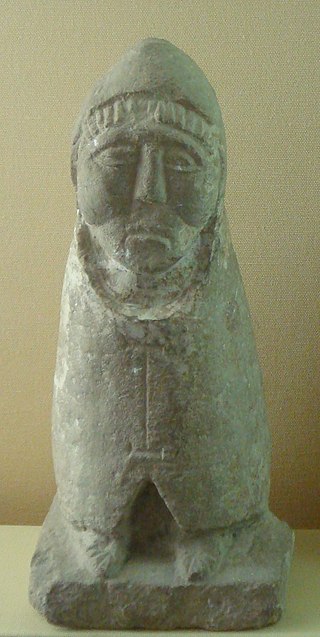
In ancient Greek religion, Telesphorus was a minor child-god of healing. He was a possible son of Asclepius and frequently accompanied his sister Hygieia. He was depicted as a dwarf whose head was always covered with a cowl hood or cap.

The Roman Forum, also known by its Latin name Forum Romanum, is a rectangular forum (plaza) surrounded by the ruins of several important ancient government buildings at the center of the city of Rome. Citizens of the ancient city referred to this space, originally a marketplace, as the Forum Magnum, or simply the Forum.

Empúries was an ancient city on the Mediterranean coast of Catalonia, Spain. The city Ἐμπόριον was founded in 575 BC by Greek colonists from Phocaea. After the invasion of Gaul from Iberia by Hannibal the Carthaginian general in 218 BC, the city was occupied by the Romans. In the Early Middle Ages, the city's exposed coastal position left it open to marauders and it was abandoned.

The Campus Martius was a publicly owned area of ancient Rome about 2 square kilometres in extent. In the Middle Ages, it was the most populous area of Rome. The IV rione of Rome, Campo Marzio, which covers a smaller section of the original area, bears the same name.

The Temple of Portunus is an ancient Roman temple located in Rome, Italy. It was built beside the Forum Boarium, the Roman cattle market associated with Hercules, which was adjacent to Rome's oldest river port and the oldest stone bridge across the Tiber River, the Pons Aemilius. It was probably dedicated to the gateway god Portunus although the precise dedication remains unclear as there were several other temples in the area besides his. It was misidentified as the Temple of Fortuna Virilis from the Renaissance and remains better known by this name. The temple is one of the best preserved of all Roman temples.

A serapeum is a temple or other religious institution dedicated to the syncretic Greco-Egyptian deity Serapis, who combined aspects of Osiris and Apis in a humanized form that was accepted by the Ptolemaic Greeks of Alexandria. There were several such religious centers, each of which was called a serapeion/serapeum or poserapi, coming from an Egyptian name for the temple of Osiris-Apis.

The Basilica Julia was a structure that once stood in the Roman Forum. It was a large, ornate, public building used for meetings and other official business during the Roman Empire. Its ruins have been excavated. What is left from its classical period are mostly foundations, floors, a small back corner wall with a few arches that are part of both the original building and later imperial reconstructions and a single column from its first building phase.

Tiber Island is the only river island in the part of the Tiber which runs through Rome. Tiber Island is located in the southern bend of the Tiber.

The Temple of Saturn was an ancient Roman temple to the god Saturn, in what is now Rome, Italy. Its ruins stand at the foot of the Capitoline Hill at the western end of the Roman Forum. The original dedication of the temple is traditionally dated to 497 BC, but ancient writers disagreed greatly about the history of this site.
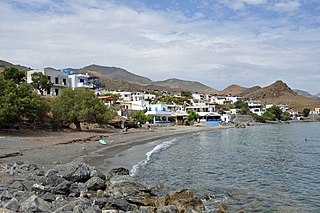
Lentas, Lentas is a coastal village 75 km south of Heraklion, on the south coast of Crete in Greece. It belongs to the community of Miamou within the municipality of Gortyna.

The Temple of Apollo Sosianus is a Roman temple dedicated to Apollo in the Campus Martius, next to the Theatre of Marcellus and the Porticus Octaviae, in Rome, Italy. Its present name derives from that of its final rebuilder, Gaius Sosius.
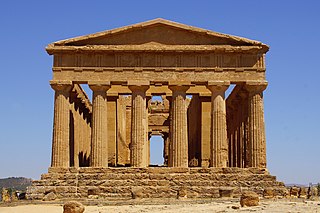
The Valle dei Templi, or Valley of the Temples, is an archaeological site in Agrigento, Sicily. It is one of the most outstanding examples of ancient Greek art and architecture of Magna Graecia, and is one of the main attractions of Sicily. The term "valley" is a misnomer, the site being located on a ridge outside the town of Agrigento.

The Temple of Eshmun is an ancient place of worship dedicated to Eshmun, the Phoenician god of healing. It is located near the Awali river, 2 kilometres (1.2 mi) northeast of Sidon in southwestern Lebanon. The site was occupied from the 7th century BC to the 8th century AD, suggesting an integrated relationship with the nearby city of Sidon. Although originally constructed by Sidonian king Eshmunazar II in the Achaemenid era to celebrate the city's recovered wealth and stature, the temple complex was greatly expanded by Bodashtart, Yatonmilk and later monarchs. Because the continued expansion spanned many centuries of alternating independence and foreign hegemony, the sanctuary features a wealth of different architectural and decorative styles and influences.

The Sanctuary of Asclepius was a sanctuary in Epidaurus dedicated to Asclepius. Especially in the Classical and Hellenistic periods, it was the main holy site of Asclepius. The sanctuary at Epidaurus was the rival of such major cult sites as the Sanctuary of Zeus at Olympia and Apollo at Delphi. The temple was built in the early 4th century BC. If still in use by the 4th century AD, the temple would have been closed during the persecution of pagans in the late Roman Empire, when the Christian Emperors issued edicts prohibiting non-Christian worship. In 1988, the temple was inscribed on the UNESCO World Heritage List because of its exceptional architecture and its importance in the development and spread of healing sanctuaries (asclepeion) throughout Classical Antiquity.

The Basilica Sempronia was a structure in the Roman Forum during the Republican period. It was one of four basilicas to make up the original Roman Forum alongside the Basilica Porcia, Basilica Aemilia, and Basilica Opimia, and was the third built. Although excavations have revealed remains of the basilica as well as the structures that originally stood in its place, none of them are visible from the Roman Forum.

The Asclepieion of Athens was the sanctuary built in honour of the gods Asclepius and Hygieia, located west of the Theatre of Dionysos and east of the Pelargikon wall on the southern escarpment of the Acropolis hill. It was one of several asklepieia in the ancient Greek world that served as rudimentary hospitals. It was founded in the year 419–18 BCE during the Peloponnesian War, perhaps as a direct result of the plague, by Telemachos Acharneas. His foundation is inscribed in the Telemachos Monument, a double-sided, marble column which is topped by reliefs depicting the arrival of the god in Athens from Epidaurus and his reception by Telemachos. The sanctuary complex consisted of the temple and the altar of the god as well as two galleries, the Doric stoa which served as a katagogion for overnight patients in the Asklepieion and their miraculous healing by the god, and the Ionic Stoa that served as a dining hall and lodging for the priests of Asclepius and their visitors.























